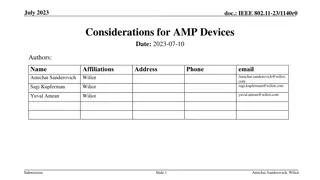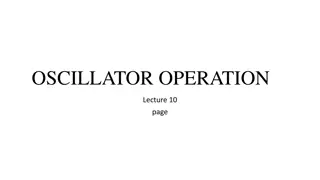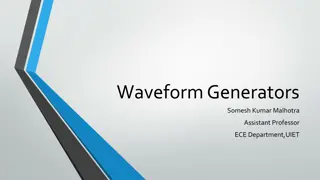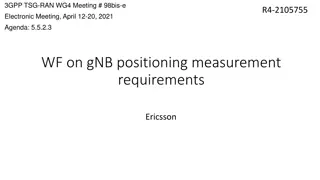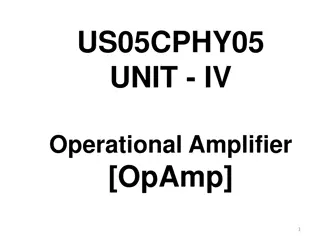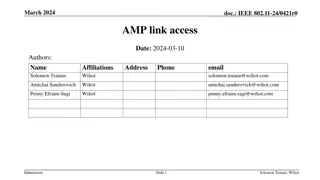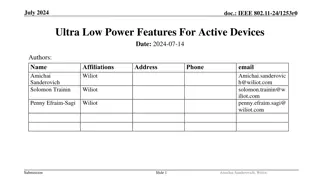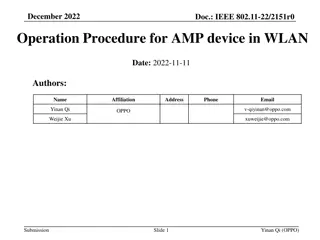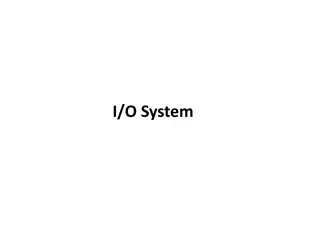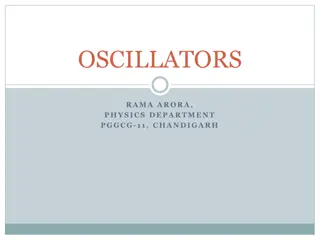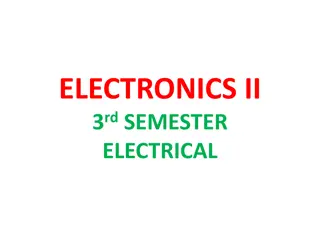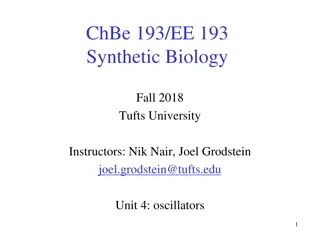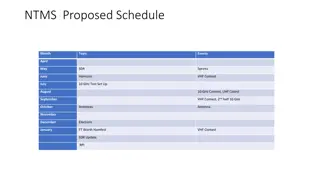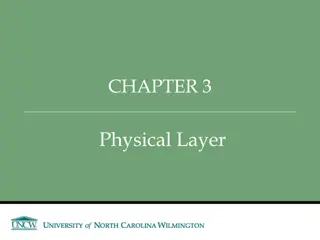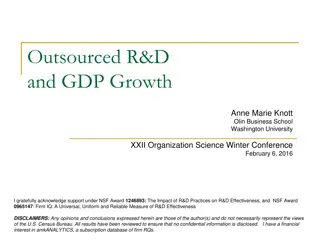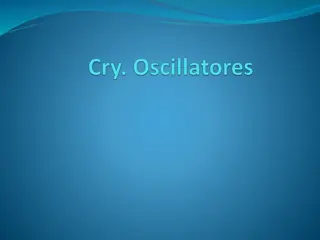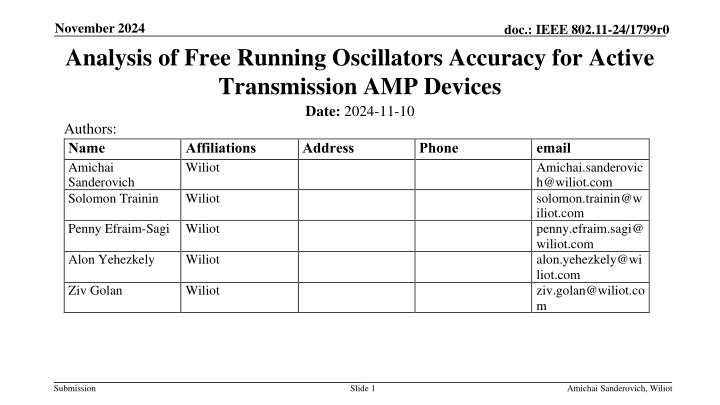
Analysis of Free Running Oscillators for Active Transmission Devices
Explore the feasibility of clock accuracy for uplink active transmission of AMP devices, focusing on free running integrated oscillators that eliminate the need for external components. Discussing factors like noise, temperature, and receiver requirements to enable simple and low-power devices in RF applications. Examining examples of GHz oscillators and current solutions for temperature compensation in RF oscillators.
Download Presentation

Please find below an Image/Link to download the presentation.
The content on the website is provided AS IS for your information and personal use only. It may not be sold, licensed, or shared on other websites without obtaining consent from the author. If you encounter any issues during the download, it is possible that the publisher has removed the file from their server.
You are allowed to download the files provided on this website for personal or commercial use, subject to the condition that they are used lawfully. All files are the property of their respective owners.
The content on the website is provided AS IS for your information and personal use only. It may not be sold, licensed, or shared on other websites without obtaining consent from the author.
E N D
Presentation Transcript
November 2024 doc.: IEEE 802.11-24/1799r0 Analysis of Free Running Oscillators Accuracy for Active Transmission AMP Devices Date: 2024-11-10 Authors: Name Affiliations Address Amichai Sanderovich Solomon Trainin Wiliot Phone email Amichai.sanderovic h@wiliot.com solomon.trainin@w iliot.com penny.efraim.sagi@ wiliot.com alon.yehezkely@wi liot.com ziv.golan@wiliot.co m Wiliot Penny Efraim-Sagi Wiliot Alon Yehezkely Wiliot Ziv Golan Wiliot Submission Slide 1 Amichai Sanderovich, Wiliot
November 2024 doc.: IEEE 802.11-24/1799r0 Abstract During last meeting, clock accuracy of 1000ppm was suggested [1] for uplink active transmission of AMP devices. We provide some analysis for the feasibility of such clock accuracy for simple and low power devices such as AMP. Submission Slide 2 Amichai Sanderovich, Wiliot
November 2024 doc.: IEEE 802.11-24/1799r0 Free Running Integrated Oscillators Definition On-chip integrated oscillators that operate independently without frequency-locking to off-chip components like XTAL, MEMS, or BAW devices. Motivation Required for enabling simple AMP devices by eliminating the need for additional external components. Required for RF harvesting AMP devices that need to operate with very low energy compared to systems using frequency-locking to external devices. Focus RF integrated LC-type oscillators Impacting factors that will be discussed Noise Temperature Temperature compensation Receiver and preamble requirements Submission Slide 3 Amichai Sanderovich, Wiliot
November 2024 doc.: IEEE 802.11-24/1799r0 Example: Free-Running Integrated GHz Oscillators Oscillator Type Frequency Temp. Coefficient (un-compensated) Noise Frequency deviation (Allan deviation) 1sec <15ppm (from graph) 1sec =0.25 ppm (after divider) 1sec>100ppm 1sec<0.1ppm Power Consumption Comments LC2 2600 GHz <0.5mW 95ppm/ C LC3 1380 MHz 4.25mW 44.5 ppm/ C (avg. over 220 C ) NA Ring4 Quartz Crystal 2440MHz 8MHz-80MHz 1.25mW >1mW OTA calibration Not including GHz LO synthesis ~ 0.25ppm/ C Given their performance advantage, the remaining of this discussion will focus on LC-based free-running integrated oscillators Submission Slide 4 Amichai Sanderovich, Wiliot
November 2024 doc.: IEEE 802.11-24/1799r0 Temperature-Compensating an Oscillator Current Solutions: Academic and commercial solutions achieve about the industrial temperature range [4,5] These solutions typically target systems with power consumption greater than 10 mW Transient temperature tracking speed is not reported Discussion: Further work is needed to enable temperature compensated RF oscillators for ~25 C /sec at X100 lower power/energy consumption Hence it is recommended to relax temperature compensation requirements to 1000ppm over the industrial temperature range 250 ppm over Submission Slide 5 Amichai Sanderovich, Wiliot
November 2024 doc.: IEEE 802.11-24/1799r0 Example for Implementation Manufectured batch shows 15,000ppm without any temperature compensation When applying temperature compensation resolution of 50C we get a maximum of 650ppm over entire batch Measuring temperature with 50C accuracy (e.g. [7-8], sub 1nJ) consumes about x10-x100 less energy compared to 10C (e.g. [9-10] over 20nJ) We estimate that 50C accuracy will require temperature measurement no more than once in 150ms while 10C will require at least 5 times that, once in 30ms. Thus we estimate energy consumption of 10C accuracy is x50-x500 more compared to 50C accuracy. Accuracy with 5C compensation 800 700 600 500 PPM 400 300 200 100 0 0 20 40 60 80 100 120 Device # Submission Slide 6 Amichai Sanderovich, Wiliot
November 2024 doc.: IEEE 802.11-24/1799r0 Configurable Oscilators Any approach for using a free-running oscilator would require some control knobes in the oscilator to compensate over process variation and also temperature variations and get to an accuracy of 1000ppm These knobes are expected to be used also for e.g. channel selection. Sometimes these control knobes are sensitive to PVT by themselves. One approch to resolve this sensitivity is by including an additional knobless stable oscilator and some simple calibration hardware. Configurable LO Knobless LO control knobs ~ ~ Calibration Submission Slide 7 Amichai Sanderovich, Wiliot
November 2024 doc.: IEEE 802.11-24/1799r0 Receiver Considerations When decoding OOK with Manchester and convolution code FEC (see [11]), the receiver needs to estimate the clock offset from the AMP transmitter. The required residual frequency error of that estimation depends on the bandwidth of the transmission. The lower the bandwidth more SNR gain can be obtained for lower residual frequency error. E.g. for 4 Mbps, no frequency estimation at all results with 1.1dB loss while 100ppm residual frequency error results with <0.2dB loss. On the other hand, lower bandwidth is more sensitive, e.g. 0.5MHz will need less than 10ppm for loss < 1dB. 1.2 1 SNR degradation [dB] 0.5MHz [125kbps] 4MHz [1Mbps] 16MHz [4Mbps] 0.8 0.6 0.4 0.2 0 101 102 103 RX residual ppm Submission Slide 8 Amichai Sanderovich, Wiliot
November 2024 doc.: IEEE 802.11-24/1799r0 Receiver Considerations [cont.] An OOK short training field (AMP-STF) is transmitted before the data and then used by the receiver to overcome the ppm difference (AMP-STF is narrower BW vs data). No coherency is assumed during the AMP-STF, to allow the AMP-device to shot-down and save power during the OFF times We considered two types of frequency mismatch estimation algorithms in the receiver Simple based on auto-correlation More complex assuming the availability of FFT with N=64 Eventhough we present only frequency, the same field and receiver blocks are used also for timing mismatch estimation Submission Slide 9 Amichai Sanderovich, Wiliot
November 2024 doc.: IEEE 802.11-24/1799r0 Performance CFO estimation error STD CFO estimation error STD CFO estimation error STD Rdata=4Mbit/sec, Tsync=4us, EstMode=Autocorr Rdata=4Mbit/sec, Tsync=4us, EstMode=FFT Rdata=4Mbit/sec, Tsync=2us, EstMode=Autocorr Rdata=4Mbit/sec, Tsync=2us, EstMode=FFT 75 Rdata=1Mbit/sec, Tsync=16us, EstMode=Autocorr Rdata=1Mbit/sec, Tsync=16us, EstMode=FFT Rdata=1Mbit/sec, Tsync=8us, EstMode=Autocorr Rdata=1Mbit/sec, Tsync=8us, EstMode=FFT 600 450 Rdata=125Kbit/sec, Tsync=128us, EstMode=Autocorr Rdata=125Kbit/sec, Tsync=128us, EstMode=FFT Rdata=125Kbit/sec, Tsync=64us, EstMode=Autocorr Rdata=125Kbit/sec, Tsync=64us, EstMode=FFT 70 400 65 60 500 350 55 50 300 45 400 ppm 250 ppm ppm 40 35 200 30 300 150 25 20 100 15 200 50 10 5 0 100 -2 0 2 4 6 -2 -1 0 1 2 3 4 5 6 SNR [dB] SNR [dB] -2 0 2 4 6 SNR [dB] Payload= Rate [Mbps] Payload [us] AMP-STF [us] %overhead 200bits 0.125 1600 0.125 1600 1 1 4 4 200 200 50 50 128 64 16 8 4 2 7.41% 3.85% 7.41% 3.85% 7.41% 3.85% Submission Slide 10 Amichai Sanderovich, Wiliot
November 2024 doc.: IEEE 802.11-24/1799r0 Conclusions Our analysis indicates that a 1000ppm clock accuracy is sufficient in terms of receiver complexity, AMP-STF overheads and AMP-device simple circuitry support and productability In terms of bandwidth usage, we see no value in reducing this number further, as the bandwidth of base channel of legacy networks in 2.4GHz is 21MHz, while the maximum bandwidth of AMP devices is not expected to go beyond 16MHz Submission Slide 11 Amichai Sanderovich, Wiliot
November 2024 doc.: IEEE 802.11-24/1799r0 Strawpoll Do you agree to add the following text to sub-clause 2.1 of FRD: When performing transmission, the maximum clock offset is 10^3 ppm for AMP device supporting active transmission. Yes No Abstain Submission Slide 12 Amichai Sanderovich, Wiliot
November 2024 doc.: IEEE 802.11-24/1799r0 References [1] 11-24-1475-03-00bp-discussion-on-ultra-low-power-timing-clock [2] Wheeler, Brad, et al. "Crystal-free narrow-band radios for low-cost IoT." 2017 IEEE Radio Frequency Integrated Circuits Symposium (RFIC). IEEE, 2017. [3] Delke, Alexander S., et al. "A single-trim frequency reference achieving 120 ppm accuracy from 50 (2021): 3434-3444. [4] Burnett, David C., et al. "CMOS oscillators to satisfy 802.15. 4 and Bluetooth LE PHY specifications without a crystal reference." 2019 IEEE 9th Annual Computing and Communication Workshop and Conference (CCWC). IEEE, 2019. [5]Si4010-C2 Crystal-Less SoC RF Transmitter Rev. 1.0, Silicon Lab. Inc. [6] Greiner, Philipp, et al. "A system-on-chip crystal-less wireless sub-GHz transmitter." IEEE Transactions on Microwave Theory and Techniques 66.3 (2017): 1431- 1439. [7] M. Eberlein and H. Pretl, "A No-Trim, Scaling-Friendly Thermal Sensor in 16nm FinFET Using Bulk Diodes as Sensing Elements," in IEEE Solid-State Circuits Letters, vol. 2, no. 9, pp. 63-66, Sept. 2019, doi: 10.1109/LSSC.2019.2938140. [8] H. Xin, M. Andraud, P. Baltus, E. Cantatore and P. Harpe, "A 174 pW 488.3 nW 1 S/s 100 kS/s All-Dynamic Resistive Temperature Sensor With Speed/Resolution/Resistance Adaptability," in IEEE Solid-State Circuits Letters, vol. 1, no. 3, pp. 70-73, March 2018, doi: 10.1109/LSSC.2018.2827883. [9] T. -T. Zhang, M. -K. Law, P. -I. Mak, M. -I. Vai and R. P. Martins, "Nano-Watt Class Energy-Efficient Capacitive Sensor Interface With On-Chip Temperature Drift Compensation," in IEEE Sensors Journal, vol. 18, no. 7, pp. 2870-2882, 1 April1, 2018, doi: 10.1109/JSEN.2018.2803203 [10] B. Yousefzadeh and K. A. A. Makinwa, "A BJT-Based Temperature-to-Digital Converter With a Heater-Assisted Voltage Calibration," in IEEE Journal of Solid-State Circuits, vol. 55, no. 2, pp. 369-377, Feb. 2020, doi: 10.1109/JSSC.2019.2953834 [11] 11-24-1497-00-00bp Uplink Rates for Active Transmission C to 170 C." IEEE journal of solid-state circuits 56.11 0.25 C 3 -Inaccuracy From 40 C to +180 C Using Submission Slide 13 Amichai Sanderovich, Wiliot




